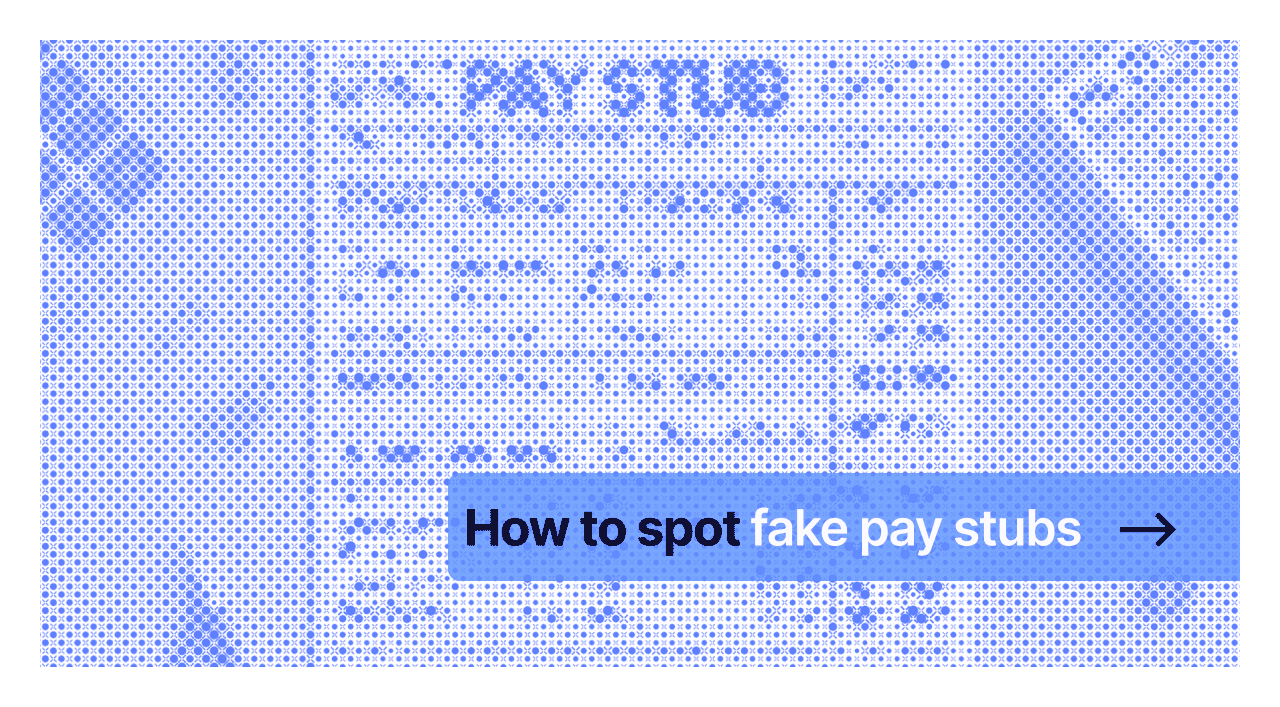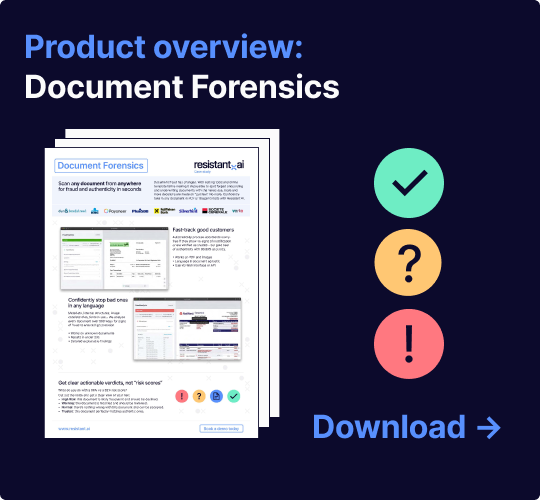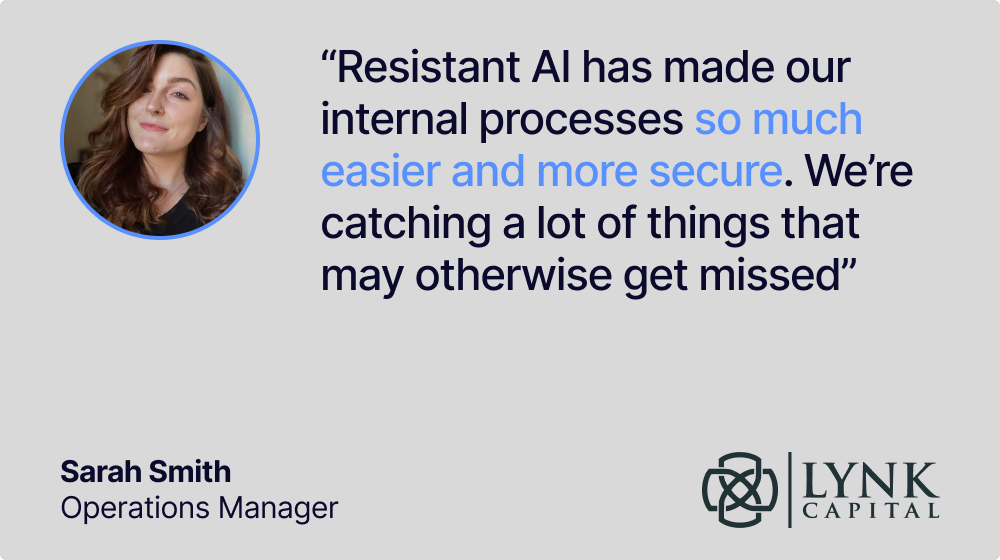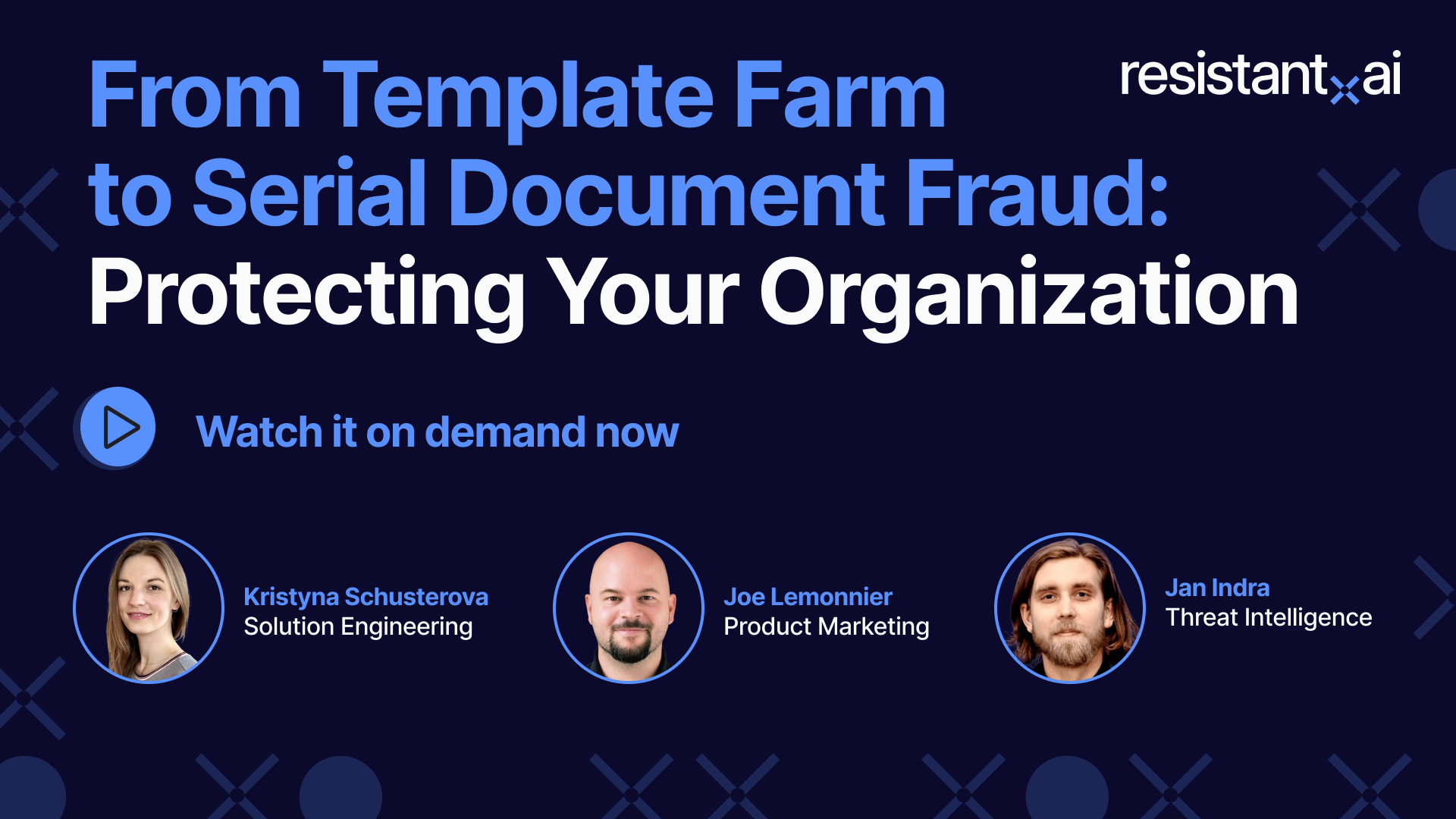How to spot fake pay stubs

Pay stubs are crucial for securing loan and lease approvals, serving as a proof of income for lenders, property managers, and employers. However, fake pay stubs can mislead organizations, often resulting in defaulted loan payments and unpaid rent.
The prevalence of fraudulent pay stubs surged by 6.2% between the second quarter of 2022 and 2023, posing significant challenges for property firms, lenders, and employers. This increase is largely due to the rise of fake pay stub generators and template farms, which have made creating fraudulent documents alarmingly easy. With over 200+ pay stub templates available on sites like Doc Juicer, producing fake pay stubs has become increasingly simple.
Given the importance of pay stubs as proof of income, learning how to spot pay stub fraud is an essential fraud prevention skill for anyone working in the lending and rental industries.
What is a pay stub?
A pay stub, also called a payslip in the UK, is a document provided by an employer that outlines an employee's earnings and deductions for a specific duration. It also acts as a proof of income document for loan applications, rental agreements, and employment contracts.
A pay stub typically includes:
- Employee Information: Name, address, and Social Security number.
- Employer Information: Company name, address, and tax identification number.
- Earnings: Gross pay, net pay, and hours worked.
- Deductions: Taxes withheld, benefits, and other deductions.
These details help underwriters, property managers, and landlords assess an applicant’s financial stability, enabling them to make informed decisions.
How is a pay stub different from a W2?
A pay stub is a document that records an employee’s earnings and deductions, while a W-2 form, also known as a wage and tax statement, is a US document provided by employers for tax reporting. Both documents can serve the same purpose as proof of income, but they have distinct differences:
- A pay stub shows the earnings for a specific pay period, while a W-2 form reports an employee’s annual income.
- Pay stubs focus on gross wages whereas W-2 forms display taxable income for the entire fiscal year—which can lead to discrepancies when comparing both documents.
- Non-taxable benefits (such as health savings accounts, fringe benefits, bonuses, additional overtime, or other deductions) are present on pay stubs, but not on W-2 forms.
- Employers must send W-2 forms to all employees by the end of January for the previous fiscal year, but pay stubs are usually issued monthly or biweekly.
- Bonuses, overtime pay, and extra income are categorized differently on W-2 forms compared to pay stubs.
Despite these differences, both types of proof of income documents can be falsified or modified to pass certain criteria in the tenant or loan application process.
Why are pay stubs important?
Pay stubs are the most common documents used for proof of income across specific situations, such as:
- Loan underwriting: Lenders use applicant pay stubs to verify creditworthiness during the underwriting process. This helps them manage credit risk and minimize their exposure to potential defaults.
- Tenant screening: Pay stubs give landlords key information to choose reliable tenants with steady jobs and consistent income, reducing the risk of unpaid rent and tenant delinquency.
- Employment screening: Companies verify applicant pay stubs to gain deeper insight into a candidate’s financial responsibility and stability, especially for management positions that have access to a company’s financial resources or budgets.
- Mortgage underwriting: Lenders use utility bills as proof of address to verify where a mortgage loan applicant currently lives. This helps prevent potential fraud and missed payments by ensuring applicants aren't applying for loans from a different location.
Signs of a forged or fake pay stub
One way to detect fraudulent pay stubs is to pay attention to red flags that indicate suspicious activity. Here’s a comprehensive list to help you spot fake pay stubs effectively:
1. Inconsistent formatting
A telltale sign of fake pay stubs is irregular formatting. Authentic pay stubs usually follow a standardized format, while fake ones may have discrepancies such as:
- Font variations: Different fonts and sizes used within the same document.
- Alignment issues: Misaligned text, uneven spacing, margins or columns.
- Poor presentation: The overall document looks unprofessional, untidy, and crooked.
- Missing data: Personal details of the applicant, such as tax identification number, full legal name, address, may be missing or omitted.
- Pixelated logos or fonts: Altered pay stubs tend to have distorted fonts or logos.
- Low-quality watermarks: Fake pay stubs usually feature unprofessional-looking watermarks with poor resolution or incorrect sizes.
- Faded or blurry texts: Washed-out or smudged texts can indicate fake pay stubs, as most companies use high-resolution typefaces.
- Pay stubs not in PDF format: Pay stubs that are not in PDF format should be scrutinized because you are not dealing with the original document, and fraudsters may have taken screenshots or photos in order to hide modifications.
2. Incorrect or misleading information
All pay stubs should ideally be cross-referenced with other documentation to verify the information and identity provided by the applicant, ensuring accuracy and authenticity. Common red flags for pay stub fraud include:
- Employee details: Misspellings or incorrect Social Security numbers.
- Employer Information: Employer’s details that do not match official records.
- Inconsistent information: Gross pay is lower than the net pay, or the applicant’s legal name varies across different documents.
- Mismatched data after cross-referencing: Personal details, such as legal name, address or employer name on the pay stub differ from other documents like bank statements or identification documents. Discrepancies between income listed on the bank statements and the pay stubs may indicate fraud.
- Inconsistent address: Fraud may be suspected when the employee works and lives in different states, with inconsistent addresses across their bank statements, credit reports, pay stubs, etc.
3. The math does not work
A real pay stub’s math should always be accurate, including a clear breakdown and deductions that correspond with the net salary. Here are some red flags to watch out for:
- Pay stub vs W-2: A major red flag occurs when the final pay stub shows a lower wage than the W-2 form, which is impossible since W-2 forms report all taxable income.
- Salary discrepancies: Annual salaries listed on a biweekly or monthly pay stub may indicate pay stub fraud.
- Round numbers: Rounded numbers for net wages can indicate pay stub fraud because it is highly unlikely to maintain a round number after benefits, deductions, and taxes.
- Exorbitant wages: Salaries that are significantly higher than the industry’s average may signal pay stub fraud.
- Lack of an hourly rate: American pay stubs should indicate an hourly rate. However, European and some Asian countries use monthly pay stubs—except Japan, which issues bi-monthly pay stubs.
- Incorrect taxes: Taxes that do not align with the salary, such as identical tax amounts for different salaries across several documents, can indicate fraud.
- Bonus Payments: Bonuses that do not align with the job position or industry averages are suspicious.
- Excessive overtime: Part time roles showing unrealistic overtime, such as 80 hours or more in a month, could be fraudulent.
4. Pay stub inconsistencies
Real pay stubs often include official branding from the employer, consistent pay dates, and a professional appearance. On the other hand, falsified pay stubs usually have inconsistencies such as:
- Lack of contact information: Altered pay stubs often lack contact details for HR or payroll departments.
- Abnormal pay day: Pay periods typically start at the beginning or end of the week, so a pay stub showing a payday in the middle of the week may be suspicious.
- Inconsistent pay periods: Pay dates that vary unpredictably throughout employment may indicate pay stub fraud.
- Prompt payment: Falsified pay stubs might show salaries paid the day after the invoice is issued—which is highly unusual.
- Missing sections: Fake pay stubs often omit details on benefits, retirement contributions (such as 401K), and taxes—which are usually present on real pay stubs.
5. Metadata discrepancies
Altered pay stubs can contain metadata discrepancies that indicate forgery. Pay attention to the following:
-
Time stamps: Different time stamps do not always indicate fraud, as creation and modification dates can be altered automatically by software. However, cross-referencing pay stubs with other documents can help spot inconsistencies. If a pay stub’s creation and modification date is before the pay period or has irregular payment processing timelines, it may indicate pay stub fraud.
-
Producer: This field shows the software used to produce the document. It should never list software like Photoshop, which are commonly used to modify documents.
-
Creator: Creators indicate which program modified the document. If a PDF editor is listed, it might suggest that some aspects of the pay stub have been modified.
-
Author: This field shows who modified the document. If it lists the applicant’s name, it raises concerns; if it shows the employer’s name, the pay stubs are likely genuine.
Manual reviews of metadata have limitations as experienced fraudsters can modify a file’s metadata, making it difficult to detect document fraud through visual inspection alone. For this reason, using an AI document fraud detection tool significantly enhances the ability of lenders, property firms, and employers to prevent document fraud.
How to verify pay stubs?
There are two primary ways to verify applicant pay stubs: conducting manual reviews or using AI software. A layered approach with AI is recommended due to the sophisticated defrauding techniques used to create fake pay stubs. Manual inspections are less reliable as the naked eye often fails to detect minute changes in metadata, formatting, and even fonts. Here’s how you can get started:
Cross reference all documents and channels
Underwriters, landlords, and property managers can reduce pay stub fraud by exercising due diligence and cross referencing data across all relevant documents and channels. Here’s how:
- Contact employers: Call the applicant’s employers to verify their legal name, address, and income. This helps to confirm the applicant’s identity and ensures that only traceable, real pay stubs are submitted.
- Check identification numbers: Verify tax identification (TIN) or Social Security numbers online using governmental sites. For European applicants, check TIN; for American applicants, verify with the IRS or the SSA.
- Calculate taxes: Cross-check tax returns or deductibles listed on the pay stubs with the IRS or other tax agencies to ensure accuracy.
- Use the IRS: Request applicants to enable the Income Verification Express Service so you can obtain official tax transcripts, which can be cross referenced with submitted pay stubs.
- Cross-reference all documents: Ensure consistency in the legal name, address, wages, and other information across all documents including tax returns, pay stubs, bank statements, etc.
- Look up LinkedIn: Review the applicant’s LinkedIn profile to confirm that their work history aligns with the pay stubs they’ve submitted.
However, these tasks are costly, labor-intensive, and time-consuming for lenders, real estate firms, and employers to spot fake documents. Furthermore, manual due diligence can prevent firms, especially fintech lenders, from scaling efficiently when applicants seek a faster loan application process.
Use AI and machine learning software
Using AI and machine learning to automate the income verification process can greatly help lenders, real estate firms, and employers mitigate risks and prevent fraud. The best approach to verifying applicant pay stubs involves combining document fraud software and document processing tools for fast and accurate results. Here are some technologies that can help:
-
Deploy a fake pay stub scanner: AI-powered document fraud software can detect fake paycheck stubs within seconds—while indicating exactly where and when forgery occurred.
-
Extract content with an Intelligent Document Processing (IDP) solution: IDP is an effective way to process, extract, and cross-check data with external sources like employer, credit bureaus or other financial institutions. Automating document processing workflows without errors ensures a reliable method for identifying fraudulent pay stubs.
Combining these solutions not only streamlines the income verification process, but also makes it more efficient and effective. By using automated tools, lenders, landlords, and property managers can save valuable time and resources, allowing them to focus on scaling their business.
What to look for in an AI-driven document fraud detector?
AI and machine learning greatly enhance a company’s proof of income processes by improving precision and accuracy in detecting fraudulent pay stubs—with low false positives. Here are five essential components that a good AI document fraud detection software should have:
-
High accuracy: An AI-powered document fraud detector must verify pay stubs with a high level of accuracy to give underwriters the confidence to process large volumes swiftly. This includes identifying subtle signs of forgery, fake templates, and other fraud indicators that are often undetectable to the human eye, ensuring that fraudulent pay stubs don’t slip through any loan underwriting processes.
-
Support for multiple document formats: An AI document fraud detection software that analyzes different document formats like PDF, JPEG, and PNG facilitates smoother loan underwriting processes by giving customers more options to submit documents.
-
Clear verdicts: A high-quality AI document fraud detector should deliver clear verdicts that require no further interpretation, allowing you to approve or deny pay stubs based on clear, evidence-backed results, thereby minimizing potential risks.
-
Explainable results: Explainable results enable underwriters to understand the risk each pay stub carries, helping them assess its authenticity and verify an applicant’s details.
-
Configurable to match your risk appetite: The best AI document fraud detector can be configured by businesses to detect outcomes with their risk appetite—only approving pay stubs that only come in certain formats, for example.
Detect fake pay stubs in seconds with Resistant AI
With Resistant AI’s automated document fraud detector, lenders, landlords, and property managers can effectively spot altered or fake pay stubs in under 20 seconds.
The best part?
Lenders can save up to 52 minutes per case investigation and still detect 32% more fraud, effectively preventing potential losses with an automated workflow. In addition, the software is user-friendly, featuring a drag-and-drop function that integrates the income verification process seamlessly with a firm’s existing workflows.
Ready to start?
Verify pay stubs securely with Resistant AI today.
Frequently Asked Questions (FAQ)
How to spot fake pay stubs with AI?
AI-driven document fraud detection software like Resistant AI can be used manually right away, and is one of the most effective tools for identifying fake pay stubs, because it looks at whether a paystub was modified. Meanwhile, intelligent document processing solutions, which combine OCR with large language models can look at the content and help speed up its analysis for inconsistencies with other sources—however, they will not check to see if the content they are analyzing is legitimate in the first place.
Is making a fake pay stub illegal?
Making a fake pay stub is not illegal but using it as a proof of income is. This can lead to hefty penalties o
Is there software to detect fake pay stubs?
Document fraud detection software like Resistant AI can help detect falsified pay stubs in under 20 seconds, as well as any other type of modified or fake document.
Is making a fake pay stub illegal?
Making a fake pay stub is not illegal but using it as a proof of income is. This can lead to hefty penalties or jail time.
Is a pay stub the same as a paycheck?
No, a paycheck indicates the amount earned, while a pay stub provides a detailed breakdown of earnings.



